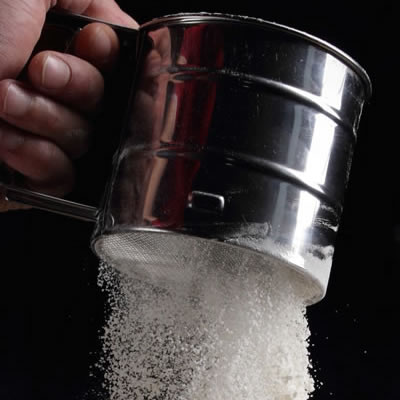Origin
Flour enrichment began due to the increase in the diseases caused by vitamin and mineral deficiancies.1 The nutritional needs of North Americans are re-evaluated periodically and flour enrichment is adapted. The use of enriched flour is less common in countries where wholemeal flour is preferred.
This process provides an important source of iron in the diet. In the U.S., flour enrichment was established in the 1930’s as the popularity of white flour increased. Health concerns about the rise in cases of diseases such as beriberi and pellagra led to an examination of white flour. Both beriberi and pellagra are caused by vitamin and mineral deficiencies. The addition of B vitamins and iron to white flour eliminated the diseases beriberi and pellagra. 3
The initial enrichment of white flour called for niacin, thiamin, riboflavin and iron. In the 1990’s folic acid was added in order to prevent the risk of coronary heart disease and birth defects such as spina bifida.1
Function
Flour enrichment provides added minerals and vitamins to refined white flour:4
- Thiamin aids digestion and helps the body process fat and carbohydrates.
- Riboflavin is an essential vitamin that aids the body in the use of protein.
- Niacin is responsible for preventing pellagra.
- Pellagra is a nutrients deficiency disease that can lead to death if untreated. Iron is essential to prevent anemia.
- Iron carries oxygen from the lungs to other parts of the body.
Nutrition
Flour enrichment for white flour per pound has the following:2
- Thiamin: 2.9 milligrams
- Riboflavin: 1.8 milligrams
- Niacin: 24 milligrams
- Folic acid: .7 milligrams
- Iron: 20 milligrams
Commercial production
Wheat goes through the milling process to become flour. White flour that is produced from the grounded endosperm of the wheat kernel has had all vitamins and minerals striped. After processing white flour is run through a device that measures out specified quantities of enrichment.4 If the flour is self-rising, a leavening agent, salt and calcium are also added in exact amounts.4
Application
Flour enrichment allows for greater nutritional availability to refined white flour.
It can be used in bread, cakes, cookies, and quick breads. Enriched flour may be used in formulas the same way as ordinary flour.
FDA regulation
The FDA provides specific guidelines for flour enrichment under CFR § 137.165.5.2 Enriched flour must conform to the U.S. Standards of Identify.5
According to FDA regulations, flour enrichment or fortification of food products are not mandatory. A policy is in place to identify fortification practices that food manufacturers should follow along with labeling guidelines.3
References
- Figoni, P. “Chapter 5 Wheat Flour.” How Baking Works: Exploring the Fundamentals of Baking Science, 3rd ed., John Wiley & Sons, Inc., 2008, pp. 74–77.
- “CFR – Code of Federal Regulations Title 21.” Accessdata.fda.gov, www.accessdata.fda.gov/scripts/cdrh/cfdocs/cfcfr/CFRSearch.cfm?fr=137.105.
- Institute of Medicine (US) Committee on Use of Dietary Reference Intakes in Nutrition Labeling. “Overview of Food Fortification in the United States and Canada.” Dietary Reference Intakes: Guiding Principles for Nutrition Labeling and Fortification., U.S. National Library of Medicine, 1 Jan. 1970, www.ncbi.nlm.nih.gov/books/NBK208880/.
- Wheat: From Field to Flour. Nebraska Wheat Board, 2009, pp. 19-26
- “COMMERCIAL ITEM DESCRIPTION FLOUR .” Agricultural Marketing Service, 29 Dec. 2008, www.ams.usda.gov/. A-A-20126F https://www.ams.usda.gov/sites/default/files/media/CID%20Flour.pdf

